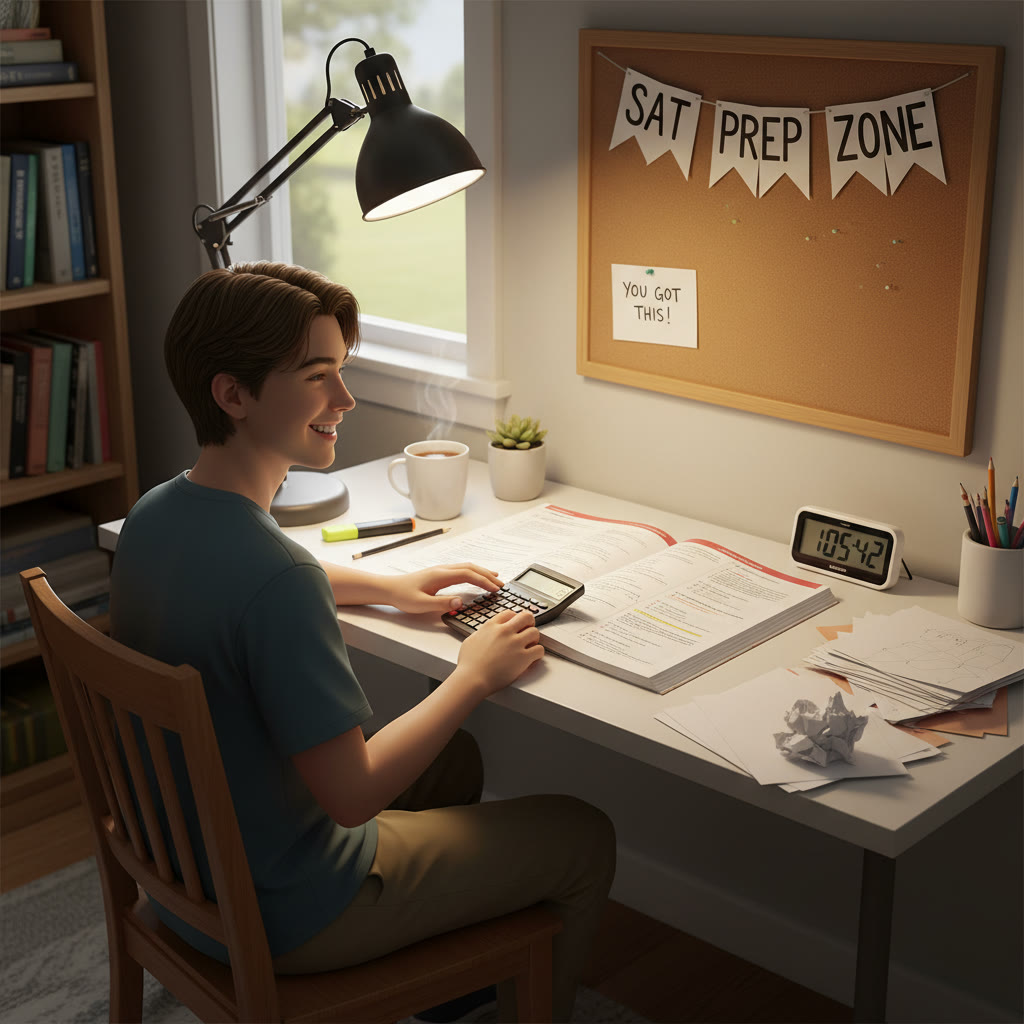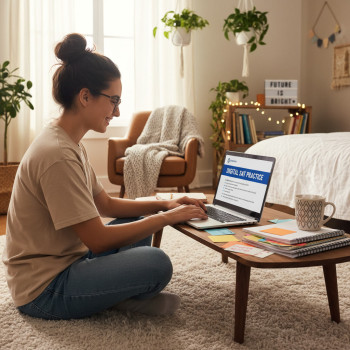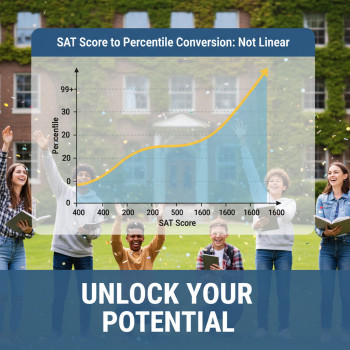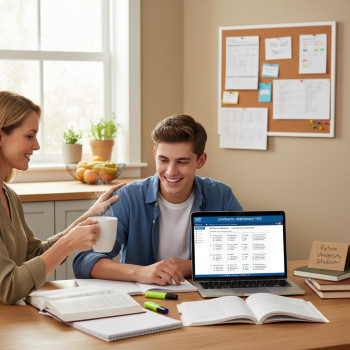Why the Room Where You Practice Matters More Than You Think
When most students think about SAT preparation they picture flashcards, content review, and the occasional practice test tucked into a weekend afternoon. But the space and conditions in which those practice tests happen—lighting, noise, timing, seating, and even the feel of the pencil—shape how well the practice transfers to real test day. That transfer is crucial: the goal of a practice test isn’t just to get a score; it’s to build habits, confidence, and strategies that hold up under pressure.
Quick preview: what this post covers
- Why practice-test environment influences results (psychology + physiology).
- Concrete differences between relaxed practice and high-fidelity simulation.
- How feedback style and timing affect learning from practice tests.
- Practical checklists, sample setups, and a table that summarizes variables.
- How guided tutoring—like Sparkl’s personalized approaches—can tailor practice environments to you.
The psychology behind environment and performance
Human behavior is context-dependent. When you walk into a classroom that looks, feels, and times you like an actual testing center, your brain starts to respond differently: attention narrows, arousal levels change, and memory retrieval patterns alter. That can be helpful or harmful depending on the match between your practice environment and test day.
Two psychological mechanisms are especially important:
- State-dependent learning — We tend to recall information better when our physiological and emotional state during retrieval matches the state during learning. If you always study vocabulary late at night on your bed, you may find recall easier in the same setting and harder during a morning test at a desk.
- Stress inoculation — Controlled exposure to a mild stressor (timed sections, simulated proctoring) helps you acclimate so your performance doesn’t collapse when anxiety spikes on the real test. But poor exposures—too chaotic, too different—can teach unhelpful coping habits.
Physical factors that subtly change outcomes
Physical conditions are often overlooked. Here are the factors that consistently show up in student feedback and educational research as affecting practice-test performance.
- Lighting: Harsh fluorescent lights can be fatiguing; warm, even light reduces eye strain and helps sustained focus.
- Seating and posture: Sitting the same way you will on test day (straight-backed chair, table height) conditions your body for long stretches of concentration.
- Noise level: Silent rooms, or rooms with the right kind of background noise, can either help or hurt depending on a student’s tolerance for distraction.
- Temperature and ventilation: Slightly cool, well-ventilated rooms usually help alertness. A stuffy room induces drowsiness that compounds over sections.
Example: the home vs. test-center divide
Imagine two students, each scoring 1100 on an untimed, relaxed practice at a kitchen table. The first consistently practices in the same quiet corner with timed sections and a strict start at 9am; the second crams sporadically at night with music and snacks. On test day, the first student’s internal rhythms and stress-management strategies are conditioned to the event, so they tend to perform closer to practice scores. The second often underperforms because their practice didn’t replicate key constraints.
The role of timing and pacing—it’s not just “finish the section”
Time pressure is the SAT’s most reliable stressor. But how you implement timing in practice matters a lot.
- Strictly timed sections: Replicates test-day pacing and forces habit formation around question triage (which to answer first, when to skip).
- Segmented practice: Working on 10–15 question sets with targeted timing allows you to focus on pacing mechanics before combining them into full-length tests.
- Clock visibility: Some students need a visible countdown to learn pacing; others perform better with a single session timer so they don’t constantly clock-watch.
Training pacing is like learning any motor skill: start with slow, deliberate practice, then scale to performance tempo. The difference between practicing at 50% of test speed and 100% is similar to practicing a speech with pauses versus delivering it under stage lights.
Feedback: immediate, delayed, and the sweet spot in between
Not all feedback is created equal. The timing and type of feedback you get after a practice test influences how much you learn and how fast you correct mistakes.
- Immediate feedback (reviewing each question right after answering) helps with concept-level learning and prevents repeating the same mistake.
- Delayed feedback (reviewing at the end of a full test or the next day) strengthens memory consolidation and mirrors how you’ll have to recall strategies on test day.
- Performance analytics (score reports, section breakdowns, error patterns) is powerful when paired with a plan—raw data without direction tends to paralyze students.
This is where guided tutoring adds value. A tutor can help interpret analytics, spot patterns you would miss, and convert feedback into a tailored action plan. Sparkl’s personalized tutoring approach—one-on-one guidance, tailored study plans, and AI-driven insights—helps students decide whether immediate correction or delayed consolidation will be more effective for a given weakness.
How realistic simulation changes strategy
There’s a big difference between a practice test you treat like homework and one you treat like the SAT. Realistic simulation doesn’t mean you must recreate the exact test center; it means matching the constraints that matter most to your performance.
- Start time and routine: Practice starting your tests at the same time as your real exam, including the pre-test routine (breakfast, warm-up problems).
- Materials: Use the same kind of calculator (if allowed), pencils, and scratch paper to avoid small surprises.
- Break management: Work through breaks similarly—stand, stretch, and consume the same snacks or water you’ll have on test day.
- Proctoring mindset: If possible, simulate proctoring by having a parent or tutor enforce timing and silence. That slight social pressure changes pacing behavior.
Table: Environmental variables and practical effects
| Variable | Typical positive effect | Typical negative effect | Quick fix |
|---|---|---|---|
| Lighting | Reduces eye strain, improves focus | Harsh light causes fatigue | Use desk lamp with soft white bulb; avoid glare |
| Seating/Posture | Supports sustained attention | Slouching leads to tiredness | Use straight-backed chair and a clear desk |
| Timing fidelity | Builds pacing skill and triage habits | Untimed practice hides speed weaknesses | Use strict timers or simulated section clocks |
| Noise level | Complete silence reduces distractions | Unexpected noise can derail concentration | Practice with recorded ambient noise to desensitize |
| Feedback type | Immediate corrects misconceptions; delayed improves retention | Poorly timed feedback increases confusion | Plan feedback sessions with a tutor or self-review schedule |
Practical practice-test setups (from minimal to high-fidelity)
Not everyone has access to formal test centers for practice. Here are realistic setups depending on your resources.
1. Minimal setup (for busy students)
- Quiet corner of a home or library, desk cleared of distractions.
- Use a single timer for each section; no constant clock-checking.
- Do a full review the next day: mark error patterns and schedule targeted drills.
2. Moderate fidelity (most students can do this)
- Start at the same time as your test will begin; dress similarly (comfortable but test-appropriate).
- Simulate breaks exactly as on test day, including snack choices and bathroom timing.
- Record (or note) distraction events so you can remove them next time.
3. High-fidelity simulation (for peak performance)
- Use a proctor (friend, parent, or tutor) who enforces strict timing and silence.
- Practice in a room with similar lighting and seating to a test center; use identical materials.
- Include timed warmups and cool-down reviews; treat it as a dress rehearsal.
Real-world anecdotes: small changes, big gains
Consider Maya, a high school junior who improved her Reading section score by 5 points within a month—not by dramatic study hours but by changing her practice environment. Previously, Maya did untimed practice sprawled on her bed with music on. By switching to a desk, starting at 8:30am to match her likely test day, and using a visible countdown timer, she learned to skim passages faster and became more consistent with passage order. The environment change triggered different study behaviors that led to measurable gains.
Then there’s Jordan, who practiced in noisy living rooms and assumed that meant he would do better on test day. But the living-room practice made him tolerant of distractions while failing to condition him to handle internal pressure. Once Jordan practiced under stricter timing and occasional simulated interruptions (sudden knocks, changing ambient noise), he developed a reliable re-centering routine during breaks. That routine reduced panic and helped him maintain accuracy under time pressure.
Comparison: What you learn in different environments
Some skills only emerge under certain constraints. Here’s what typical practice environments teach you:
- Relaxed practice: Deep conceptual learning, experimentation with methods, and low-stakes review of mistakes.
- Timed, quiet practice: Pacing, triage, endurance, and the ability to maintain accuracy under time limits.
- Simulated proctoring: Managing social pressure and maintaining focus amid enforced constraints.
Combining these modes is the fastest path to improvement: build your base in relaxed practice, then layer on timing fidelity and authenticity as you approach test day.
How to design your practice-test regimen in 6 steps
- Start with a diagnostic practice test in a relaxed setting to identify content gaps.
- Create a study plan that alternates content work with timed and untimed practice sessions.
- Gradually increase simulation fidelity: controlled timing, then breaks, then proctoring.
- Pair tests with structured feedback sessions—immediate for technique work, delayed for endurance.
- Keep a simple log: environment, start time, distractions, score, and one rule you’ll change next time.
- Before the real exam, perform at least two full, high-fidelity practice tests within the same week to finalize routines.
Where guided tutoring adds leverage
Individualized help transforms practice tests from a self-guided experiment into an efficient learning engine. Tutors can:
- Identify which environmental variables most affect you personally.
- Design progressive simulations—starting with targeted drills, then timed practice, then full simulations—so you don’t burn out or learn the wrong habits.
- Use data to craft feedback that’s actionable: which question types to skip first, how to allocate minutes per passage, and how breaks should be handled.
Sparkl’s personalized tutoring combines one-on-one guidance and tailored study plans with AI-driven insights to spot subtler patterns (like a recurring error in particular math subtopics under time pressure). When a tutor knows how you react to simulated stress, they can recommend environmental changes—tiny ones that produce outsized gains.
Common pitfalls and how to avoid them
- Pitfall: Doing only relaxed practice. Fix: Introduce timed sections early, even if scores dip initially.
- Pitfall: Relying solely on raw scores without pattern analysis. Fix: Track question-type errors and time spent per question.
- Pitfall: Never simulating breaks. Fix: Incorporate them so your stamina and routine are tested.
- Pitfall: Practicing in inconsistent locations. Fix: Choose 1–2 reliable setups and alternate between them intentionally.
Sample one-month plan that emphasizes environment
This is a weekly outline for a focused month before test day. Adjust intensity by your baseline and available time.
- Week 1: Diagnostic tests (one relaxed, one timed) + create a log for environment variables.
- Week 2: Content review with brief timed drills (15–30 minutes daily) in a quiet desk setup.
- Week 3: Two full-length, high-fidelity practice tests with simulated breaks and proctoring; targeted review sessions the following days.
- Week 4: Light content tune-up, two final high-fidelity dress rehearsals, and routine stabilization (sleep, nutrition, pre-test rituals).
Image ideas


Final thoughts: small changes, steady gains
Practice tests are not neutral measurements; they’re training sessions that shape the habits you take into the exam. Small, intentional changes to the environment—timing fidelity, seating, lighting, and feedback structure—compound over weeks to produce meaningful differences in scores. Rather than treating every practice test the same, treat them as stages in a progression: diagnose, train, simulate, and refine.
And remember: you don’t have to do this alone. Personalized support—like Sparkl’s tutors providing 1-on-1 guidance, tailored study plans, and AI-driven insights—can help you identify which environmental tweaks will move your needle the fastest. When environment design and expert feedback work together, the practice-test experience becomes less about guessing and more about building reliable performance.
Actionable checklist before your next practice test
- Pick a consistent start time and stick to it.
- Clear your desk and match your seating to what you’ll have on test day.
- Decide whether you’ll show or hide the clock and test that choice during practice.
- Simulate breaks and materials exactly as you’d have on test day.
- Plan feedback: immediate for technique work, delayed for endurance.
- Log one environmental change each week and measure its effect.
Closing note
Practice tests are powerful, but only if they teach the right lessons. When you control the context—psychological and physical—you extract more learning per hour and arrive on test day with a rehearsed plan rather than wishful thinking. Make your environment intentional, mix modes of practice, and seek targeted feedback when it matters. With a little design and the right support, you’ll not just practice harder—you’ll practice smarter.
















No Comments
Leave a comment Cancel